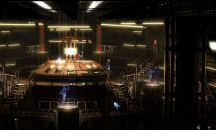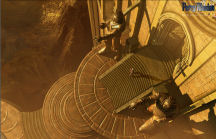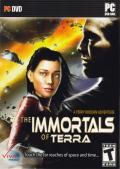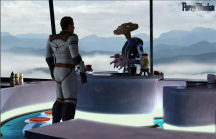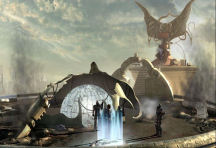This game treats us to some
gorgeous opening scenes, including a foreshadowing of two humanoids
discussing their quest for power. In another scene, robots are attacking
an athletic female, who twists off the head of one of the robots.
Cleverly written, both of these locations will be recognized later
during game play, including the discovery by the main character of the
robot head.
Cut to the Solar Residence which is under attack. Perry
Rhodan, the hero of our game, learns that he has been confined to the
damaged station for his own safety until further notice from his good
friend, the Minister of Defense. The problem is -- Perry’s estranged
companion, Mondra Diamond, has been kidnapped. So Perry is going to have
to go against orders and find a way to leave the station and track her
down. Perry will travel across the galaxy to discover who has attacked his
world and why. Who can be trusted, and who has a secret agenda that has
made for divided loyalties? What is the mysterious source that is sending
Perry messages and seems to be assisting him on his quest?
“Beam me up, Scotty” – a phrase that made its way
into pop culture associated with the science fiction television series
Star Trek, although the exact phrase was never actually spoken in any
television episode or film—Wikipedia.
Game play begins in this third person perspective
adventure game with Perry inspecting the damage to the station, talking to
everyone that he can, and figuring out how to elude his own well-meaning
security forces. Movement is via point and click, utilizing movement icons
which appear when the cursor is swept across the screen. Double clicking
the mouse makes Perry run, a welcome feature because there is quite a bit
of ground to cover as Perry goes back and forth securing items for use in
another location. Items that can be useful or people with whom
communication is possible will likewise have appropriate icons associated
with them. Inventory items can be accessed at the bottom of the screen. A
simple left click accesses an item, and a right click will give more
information about the item.
An interesting method of furthering dialogue choices and
game play (that I don’t recall seeing since the first Broken Sword game)
is that some information gained will also go into inventory for further
use. It can then be used like any other inventory item on another
character in an effort to obtain more information on the topic. Dialogue
can be speeded through by clicking the space bar, although you may miss
clues by doing so.
Permanently in inventory is a futuristic wristband that
may be helpful if you’re stuck in the game or curious about Perry’s ideas
on the investigation at any point. A left click will open it to show a
notebook which includes investigation notes and, often, clues about what
needs to be accomplished next in the game. Although you don’t have to
click on the wristband first, it has other features, including a scan mode
which enables you to tap the “s” key on your keyboard to be briefly shown
objects and exits available on screen. It also has the ability to change
Perry’s DNA and disguise him to the masses, although it never fools the
other main characters (or us, of course).
Another feature of the game is that pop-up windows
appear when nearing an entrance to a location you have previously visited.
This is helpful in a couple of places where numerous rooms adjoin a main
room. Right clicking will move Perry instantly into that other location.
I didn’t encounter any glitches and the game ran
smoothly. There are a couple of areas where an action needs to be
completed that are a bit finicky. On a couple of occasions the scan
feature did not appear to identify an object with which interaction was
possible.
As the player moves Perry around the station in an
effort to discover more clues about the attack and to find a way to leave
to find Mondra, there is a display to be accessed which briefly chronicles
Perry’s previous exploits. This gives some welcome background information
on your character, especially if you neglected to read the on-disc manual.
In addition, as play continues, information necessary to play is gained
through an intelligence system called a positronic.
Just a wee note here: as a player I would prefer a
physical manual that I can hold in my hand and refer to if necessary.
Having it on disc on an Acrobat Reader also makes the assumption that the
player has access to a reader that functions correctly. If you don’t read
the manual, you may not be aware that the wristband can be accessed as a
notebook, that you can scan the room for clues, or a variety of other
helpful information tidbits including a partial walkthrough of the first
chapter.
I don’t want to achieve immortality through my
work, I want to achieve it by not dying” – Woody Allen
There’s a lot to take in at once as you begin play.
Fortunately, you can play as slowly as you like, with no action or timed
sequences appearing at all. And also, happily, although you are obviously
in a futuristic setting, it is much like your everyday setting with
futuristic gadgets and alien beings interspersed in it. In other words,
you don’t have to struggle with a planet or dimension that doesn’t adhere
to the same use of physical senses that you are used to, as time and space
are not distorted. There are space ships and strange objects and robots
galore, but it never feels uncomfortably foreign to play. In addition,
game play is (for the most part) very linear, and characters with whom you
speak will give clues for needed investigation on your part.
The developers have been massively ambitious in
attempting to bring us up to speed with the “Perryverse”. Although Perry
Rhodan is well known to Europe and other parts of the world, he is
virtually unknown to North America. Perry made his first appearance in
Germany in 1961, and in almost fifty years has been the subject of some
two thousand weekly serialized novellas, countless novels, spin-offs and
other associated paraphernalia. While European gamers are probably very
comfortable with this world, it may be the first time a North American
gamer has heard of this Perryverse.
While the developers have made a valiant effort to
provide enough back story to familiarize the players with this world, I
can’t help thinking it feels an awful lot like opening a book in the
middle and trying to understand the whole of it. There is nothing about
the characters to draw us to them, to make us care enough to want to help
them reach their goals. I think it might have been a better tactic to make
this game a sequel, and in the first game show the events that made Perry
who he is, and how his relationships are important to him through
experiences shared. At least, much could be done with flashbacks to make
us understand Perry and his motivations a little better.
“Have you ever had a dream, Neo, that you were
sure was real? What if you were unable to wake from that dream? How would
you know the difference between the dream world…and the real world?”—The
Matrix
By way of background, the original story had Perry and
his crew of the Stardust spaceship landing on the moon. Thinking
themselves the first to do so, they instead encounter Arkonide astronauts
who are stranded there. Perry is able to make peace with them through a
romantic encounter (a museum is dedicated to this character in our game),
and thus gains technology that is thousands of years more developed than
that on Earth. With this technology, Perry is able to avert a third world
war, unite the countries on Earth and neighboring planets into Terra. An
immortal being gives Perry and his closest friends the gift of immortality
to assist them in bringing peace to the Milky Way galaxy. One of these
friends is Reginald Bull, who appears in this game as the Minister of
Defense.
The game never tells you this in its entirety, so
motivations of characters are unclear. Why Perry trusts Bull is never
understood, why Perry is willing to go against orders to find Mondra is
never appreciated, and especially why Perry makes the choices he does
toward the ending of our game are a puzzle. His limited immortality is
hazy at best.
Avoiding spoilers makes it impossible to elaborate here,
but essentially I was disappointed with the ending because I didn’t
understand the back story. It’s not a spoiler to tell you that the last
chapter of the game feels rushed and incomplete, which is unfortunate
because it had the potential to be the most interesting part of the game.
While there is little to draw you to the main
characters, there is curiously personality galore in some of the bit
players of this game. Between the somewhat tedious beginning (after the
enthralling opening cinematic) and the rushed ending, Perry travels to the
land of Elmo Dater, where the developers show glimmerings of brilliance.
There is the organized crime boss who is a Unither, a being whose most
prominent physical characteristic is a flexible trunk, and who is
obviously popular with the ladies. There are the cookie-headed Blues, who
adore their little dolls. There’s even a tough female who owns the trading
post that is lovesick for a missing miner.
“The difference between fiction and reality is
that fiction has to make sense.”- Tom Clancy
One of my favorite parts of the game takes place in an
odor bar. Instead of serving liquor, patrons are served various aromas
that have knockout potential. These potent odors give Perry (and us) a
visual feast of multi-colored exploding fireworks.
Also visually memorable in a previous chapter is Thora’s
museum. Stained glass windows, huge towers, and a colossal robot are all
well designed. The graphics are lovely in this game with much attention
paid to detail.
The graphics settings selection has lighting, shadows, background
characters, anti-aliasing, texture size and vertical synchronizing
available according to your preferences and the strength of your video
card.
“Inanimate
objects can be classified scientifically into three major categories;
those that don’t work, those that break down and those that get
lost.”—Russell Baker
Also in Thora’s
museum is a dilly of a color tile puzzle which requires the use of logic
and the ability to see the different colors. Most of the other puzzles are
far simpler, and are inventory and occasionally logic based. There is one
puzzle that utilizes the sound of crystals, but hearing it isn’t necessary
to solve it. There is a maze where you manipulate a robot through its
paces. There are no slider puzzles. As I mentioned, there are no action or
timed sequences, and your character cannot die.
There are seven save
slots, and one additional slot each for an automatic game save and a quick
save. This isn’t enough if you are like me and wish to revisit various
locations. You can save anywhere in the game outside of cut scenes or
dialogue exchanges.
The accompanying
music for the game is orchestral in nature, appropriately changing by
scene. Never overbearing, it is magical and cinematic in scope in some
places, such as the main theme. Voice work is well done and professional,
as is the ambient sound. Spaceships zoom by, footfalls sound different
according to the terrain.
There has obviously
been so much work put into this game that it has to be appreciated. I only
wish that I had been able to establish a connection with the main
characters, and that the ending had been better developed with the time it
deserved after an otherwise detailed game.
Quick list:
Third person
perspective, point and click science fiction adventure game.
No action or timed
sequences. Your character cannot die.
Inventory and logic
puzzles, including a maze.
Save at will, but
limited save slots.
The game released on DVD, and the disk
must be in the drive when you play.
No glitches, and those
with a powerhouse video card can take advantage of special features,
including shading and lighting. Regardless of this, those with a video
card that meets the recommended specs will still enjoy graphic goodness.
A professionally written
story with above average voice overs.
B +
August 2008
design copyright ©
2008
GameBoomers
Group
